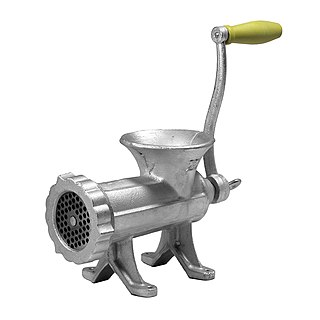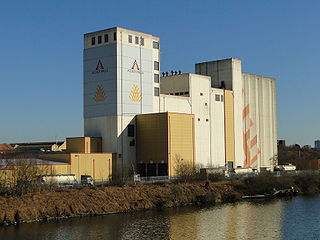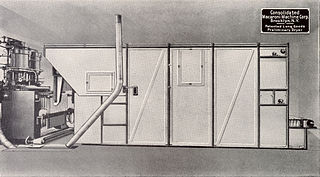A crusher is a machine designed to reduce large rocks into smaller rocks, gravel, sand or rock dust.

In industrial process engineering, mixing is a unit operation that involves manipulation of a heterogeneous physical system with the intent to make it more homogeneous. Familiar examples include pumping of the water in a swimming pool to homogenize the water temperature, and the stirring of pancake batter to eliminate lumps (deagglomeration).

A meat grinder is a kitchen appliance for fine chopping ('mincing') and/or mixing of raw or cooked meat, fish, vegetables or similar food. It replaces tools like the mincing knife. The food to be minced is placed into a funnel, which sits on top of the grinder. From there, the material enters a horizontal screw conveyor; the screw conveyor may be hand-cranked or powered by an electric motor. The screw squashes and mixes the food. At the end of the screw, the food is passed through a fixed plate, where it exits the machine. The fineness of the minced food depends on the size of the holes in the plate.

A bandsaw is a power saw with a long, sharp blade consisting of a continuous band of toothed metal stretched between two or more wheels to cut material. They are used principally in woodworking, metalworking, and lumbering, but may cut a variety of materials. Advantages include uniform cutting action as a result of an evenly distributed tooth load, and the ability to cut irregular or curved shapes like a jigsaw. The minimum radius of a curve is determined by the width of the band and its kerf. Most bandsaws have two wheels rotating in the same plane, one of which is powered, although some may have three or four to distribute the load. The blade itself can come in a variety of sizes and tooth pitches, which enables the machine to be highly versatile and able to cut a wide variety of materials including wood, metal and plastic.

A bread making machine or breadmaker is a home appliance for baking bread. It consists of a bread pan, at the bottom of which are one or more built-in paddles, mounted in the center of a small special-purpose oven. The machine is usually controlled by a built-in computer using settings input via a control panel. Most bread machines have different cycles for different kinds of dough—including white bread, whole grain, European-style, and dough-only. Many also have a timer to allow the bread machine to function without operator input, and some high-end models allow the user to program a custom cycle.
Continuous production is a flow production method used to manufacture, produce, or process materials without interruption. Continuous production is called a continuous process or a continuous flow process because the materials, either dry bulk or fluids that are being processed are continuously in motion, undergoing chemical reactions or subject to mechanical or heat treatment. Continuous processing is contrasted with batch production.

In machining, a metal lathe or metalworking lathe is a large class of lathes designed for precisely machining relatively hard materials. They were originally designed to machine metals; however, with the advent of plastics and other materials, and with their inherent versatility, they are used in a wide range of applications, and a broad range of materials. In machining jargon, where the larger context is already understood, they are usually simply called lathes, or else referred to by more-specific subtype names. These rigid machine tools remove material from a rotating workpiece via the movements of various cutting tools, such as tool bits and drill bits.
Pelletizing is the process of compressing or molding a material into the shape of a pellet. A wide range of different materials are pelletized including chemicals, iron ore, animal compound feed, plastics, waste materials, and more. The process is considered an excellent option for the storage and transport of said materials. The technology is widely used in the powder metallurgy engineering and medicine industries.

A pugmill, pug mill, or commonly just pug, is a machine in which clay or other materials are extruded in a plastic state or a similar machine for the trituration of ore. Industrial applications are found in pottery, bricks, cement and some parts of the concrete and asphalt mixing processes. A pugmill may be a fast continuous mixer. A continuous pugmill can achieve a thoroughly mixed, homogeneous mixture in a few seconds, and the right machines can be matched to the right application by taking into account the factors of agitation, drive assembly, inlet, discharge, cost and maintenance. Mixing materials at optimum moisture content requires the forced mixing action of the pugmill paddles, while soupy materials might be mixed in a drum mixer. A typical pugmill consists of a horizontal boxlike chamber with a top inlet and a bottom discharge at the other end, 2 shafts with opposing paddles, and a drive assembly. Some of the factors affecting mixing and residence time are the number and the size of the paddles, paddle swing arc, overlap of left and right swing arc, size of mixing chamber, length of pugmill floor, and material being mixed.

A screw conveyor or auger conveyor is a mechanism that uses a rotating helical screw blade, called a "flighting", usually within a tube, to move liquid or granular materials. They are used in many bulk handling industries. Screw conveyors in modern industry are often used horizontally or at a slight incline as an efficient way to move semi-solid materials, including food waste, wood chips, aggregates, cereal grains, animal feed, boiler ash, meat, and bone meal, municipal solid waste, and many others. The first type of screw conveyor was the Archimedes' screw, used since ancient times to pump irrigation water.

A conveyor system is a common piece of mechanical handling equipment that moves materials from one location to another. Conveyors are especially useful in applications involving the transport of heavy or bulky materials. Conveyor systems allow quick and efficient transport for a wide variety of materials, which make them very popular in the material handling and packaging industries. They also have popular consumer applications, as they are often found in supermarkets and airports, constituting the final leg of item/ bag delivery to customers. Many kinds of conveying systems are available and are used according to the various needs of different industries. There are chain conveyors as well. Chain conveyors consist of enclosed tracks, I-Beam, towline, power & free, and hand pushed trolleys.

A mixer-wagon, or diet feeder, is a specialist agricultural machine used for accurately weighing, mixing and distributing total mixed ration (TMR) for ruminant farm animals, in particular cattle and most commonly, dairy cattle.

A concrete plant, also known as a batch plant or batching plant or a concrete batching plant, is equipment that combines various ingredients to form concrete. Some of these inputs include water, air, admixtures, sand, aggregate, fly ash, silica fume, slag, and cement. A concrete plant can have a variety of parts and accessories, including: mixers, cement batchers, aggregate batchers, conveyors, radial stackers, aggregate bins, cement bins, heaters, chillers, cement silos, batch plant controls, and dust collectors.
In mechanical engineering, a key is a machine element used to connect a rotating machine element to a shaft. The key prevents relative rotation between the two parts and may enable torque transmission. For a key to function, the shaft and rotating machine element must have a keyway and a keyseat, which is a slot and pocket in which the key fits. The whole system is called a keyed joint. A keyed joint may allow relative axial movement between the parts.

Stedman Machine Company is a manufacturer of crushing equipment in Aurora, Indiana, United States, that was founded by Nathan Rockwell Stedman in 1834.

A gristmill grinds cereal grain into flour and middlings. The term can refer to either the grinding mechanism or the building that holds it. Grist is grain that has been separated from its chaff in preparation for grinding.

A dewatering screw press is a screw press that separates liquids from solids. A screw press can be used in place of a belt press, centrifuge, or filter paper. It is a simple, slow moving device that accomplishes dewatering by continuous gravitational drainage. Screw presses are often used for materials that are difficult to press, for example those that tend to pack together. The screw press squeezes the material against a screen or filter and the liquid is collected through the screen for collection and use.

Milling is the process of machining using rotary cutters to remove material by advancing a cutter into a workpiece. This may be done by varying direction on one or several axes, cutter head speed, and pressure. Milling covers a wide variety of different operations and machines, on scales from small individual parts to large, heavy-duty gang milling operations. It is one of the most commonly used processes for machining custom parts to precise tolerances.
A grinder-mixer is a type of agricultural machine used to process livestock feed from grain. A grinder-mixer is a portable mill that combines the mixing and grinding operations.

Pasta processing is the process in which wheat semolina or flour is mixed with water and the dough is extruded to a specific shape, dried and packaged.















